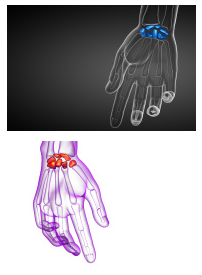Carpal Tunnel Release Surgery
Milwaukee Carpal Tunnel Doctor Accepts New Patients
Carpal tunnel release is a surgical procedure to treat carpal tunnel syndrome (CTS) of the wrist. CTS occurs as a result of the median nerve getting compressed in the carpal tunnel of the wrist. It is medically diagnosed. This is usually a slow-onset problem, and diagnosing CTS early is important to avoid permanent nerve damage. It is more common in women than men. Causes of CTS can be complex, with multiple factors that may contribute including heredity, age, and hormonal changes. Health conditions such as rheumatoid arthritis, hypothyroidism, or diabetes can all lead to carpal tunnel syndrome.
Other causes include:
- Swelling around the wrist from injuries
- Continual use of vibrating power tools
- Cyst or tumor existing in the wrist
- Poor ergonomic use of the wrists/hands
Wisconsin CTS Patients Treated by Dr. Gertel
 Typically, patients report a tingling or burning or numbness and decreased sensitivity in the affected hand. Symptoms typically appear at night, progressing to be present during the day as well. The affected hand loses strength and dexterity, making everyday activities using the affected hand very difficult. Electrodiagnostic testing (EMG/NCV tests) administered by a neurologist are commonly done to confirm the diagnosis of CTS. Depending on the severity and symptoms and/or if non-operative treatments fail, then carpal tunnel release surgery may be necessary.
Typically, patients report a tingling or burning or numbness and decreased sensitivity in the affected hand. Symptoms typically appear at night, progressing to be present during the day as well. The affected hand loses strength and dexterity, making everyday activities using the affected hand very difficult. Electrodiagnostic testing (EMG/NCV tests) administered by a neurologist are commonly done to confirm the diagnosis of CTS. Depending on the severity and symptoms and/or if non-operative treatments fail, then carpal tunnel release surgery may be necessary.
A carpal tunnel release is performed with direct visualization through a small incision. The transverse carpal ligament compressing over the underlying median nerve is released. Sutures are used to close the incision and your wrist will be placed in a splint and sling after surgery is completed. Surgery is done as an outpatient procedure (you are able to go home the same day).
There are always risks and benefits of surgery, and there are never any 100% guarantees regarding the outcome of surgery. Dr. Gertel’s goal is to minimize the risks and help guide you to the best path of recovery. A wrist support will be used for approximately 3-4 weeks after surgery. Rehabilitation with an occupational therapist may be done during your recovery. Recovery time after surgery may take up to 2-3 months depending on the physical demands of your job.
